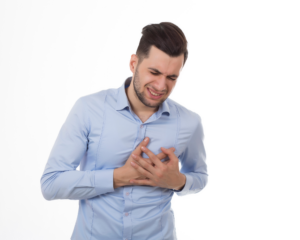What Are the Symptoms of Depression Chest Pain?
Depression chest pain is a type of physical symptom that can be experienced by people with depression. It can feel like a tightness in the chest, a burning sensation, or even a sharp pain. While it’s important to seek medical help to rule out any physical cause for the chest pain, it’s also important to recognize and understand the symptoms of depression chest pain so that you can better manage your overall mental health.

What Causes Depression Chest Pain?
Depression chest pain is thought to be caused by changes in the functioning of the nervous system. Studies have found that people with depression have an increased sensitivity to pain and stimulation, which can lead to the experience of physical sensations such as chest pain. Other factors such as stress, anxiety, and poor sleep may also contribute to the development of depression chest pain.
5 Common Symptoms of Depression Chest Pain
1. Tightness: People with depression chest pain may experience a feeling of tightness in the chest or rib cage area. This feeling may be intermittent or constant and can range from mild to severe.
2. Burning Sensation: Some people may experience a burning sensation in their chest area when experiencing depression chest pain. This burning sensation may be felt anywhere from the sternum to the shoulder blades.
3. Pressure: People with depression chest pain may also feel pressure in their chest area. This pressure may range from mild to severe and can be localized to one area or spread throughout the entire chest area.
4. Sharp Pains: People with depression chest pain may experience sharp pains in their chest area that come and go in intensity over time. These pains may range from mild to severe and can be localized or spread throughout the entire chest area.
5. Aching: Some people may experience an aching sensation in their chest that ranges from mild to severe and can last for long periods of time or come and go quickly.
When Should You See a Doctor?
It’s important to seek medical help if you are experiencing any type of physical symptom, including depression chest pain, as it could indicate an underlying physical condition such as heart disease or a pulmonary disorder. It’s also important to recognize and address any mental health issues such as depression or anxiety that could be contributing to the experience of physical symptoms such as chest pain.
How Can You Manage Depression Chest Pain?
There are several steps that you can take to better manage your depression chest pain symptoms. These include:
- Exercising regularly: Exercise can help reduce stress and improve your overall mood, which can help reduce symptoms of depression.
- Practicing mindfulness: Mindfulness activities such as meditation and yoga can help you become more aware of your thoughts and feelings, which can help reduce stress levels.
- Seeking professional help: If you are struggling with depression or anxiety, it is important to seek professional help from a mental health professional.
- Making lifestyle changes: Eating a healthy diet, getting regular sleep, avoiding alcohol and drugs, and limiting caffeine intake can all help reduce stress levels and improve your overall mood.
- Managing your stress levels: Stress management techniques such as deep breathing exercises, progressive muscle relaxation, and guided imagery can help reduce stress levels.
- Talking to friends and family: Talking to friends and family members about how you are feeling can help reduce feelings of isolation and give you support when you need it.
Conclusion
Depression chest pain is a type of physical symptom that can be experienced by people with depression. While it’s important to seek medical help to rule out any physical cause for the chest pain, it’s also important to recognize and understand the symptoms of depression chest pain so that you can better manage your overall mental health. There are several steps that you can take to better manage your depression chest pain symptoms such as exercising regularly, practicing mindfulness, seeking professional help, making lifestyle changes, managing your stress levels, and talking to friends and family members about how you are feeling.